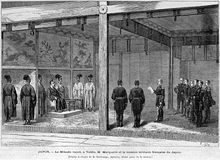- Modernization of Japanese Military 1868–1931
-
The modernization of the Japanese army and navy during the Meiji period (1868-1912) and until the Mukden Incident (1931) was carried out by the newly founded national government, a military leadership that was only responsible to the Emperor and the help of French, British, and later German military advisors.
When Western powers began to use their superior military strength to press Japan for trade relations in the 1850s, the country's decentralized and, by Western standards, antiquated military forces were unable to provide an effective defense against their advances. After the fall of the Tokugawa shogunate in 1867 and the restoration of the Meiji Emperor, de facto political and administrative power shifted to a group of younger samurai who had been instrumental in forming the new system and were committed to modernizing the military. They introduced drastic changes, which cleared the way for the development of modern, European-style armed forces.
 Reception by the Meiji Emperor of the Second French Military Mission to Japan, 1872.
Reception by the Meiji Emperor of the Second French Military Mission to Japan, 1872.
Conscription became universal and obligatory in 1872 and, although samurai wedded to the traditional prerogatives of their class resisted, by 1880 a conscript army was firmly established. The Imperial Army General Staff Office, created after the Prussian model of the Generalstab, was established directly under the emperor in 1878 and was given broad powers for military planning and strategy. The new force eventually made the samurai spirit its own. Loyalties formerly accorded to feudal lords were transferred to the state and to the emperor. Upon release from service, soldiers carried these ideals back to their home communities, extending military-derived standards to all classes.
An imperial rescript of 1882 called for unquestioning loyalty to the emperor by the new armed forces and asserted that commands from superior officers were equivalent to commands from the emperor himself. Thenceforth, the military existed in an intimate and privileged relationship with the imperial institution. Top-ranking military leaders were given direct access to the emperor and the authority to transmit his pronouncements directly to the troops. The sympathetic relationship between conscripts and officers, particularly junior officers who were drawn mostly from the peasantry, tended to draw the military closer to the people. In time, most people came to look more for guidance in national matters to military commanders than to political leaders.
The first test of the nation's new military capabilities, a successful punitive expedition to Taiwan in 1874 in retaliation for the 1871 murder of shipwrecked sailors from Ryūkyū, was followed by a series of military ventures unmarred by defeat until World War II. Japan moved against Korea and China (First Sino-Japanese War), and Russia (Russo-Japanese War) to secure by military means the raw materials and strategic territories it believed necessary for the development and protection of the homeland. Territorial gains were achieved in Korea, the southern half of Sakhalin (named Karafuto in Japanese), and Manchuria. As an ally of Britain in World War I, Japan assumed control over Germany's possessions in Asia in the Treaty of Versailles, notably in China's Shandong Province, and the German-controlled Mariana, Caroline, and Marshall islands in the Pacific Ocean.
The Naval General Staff, independent from the supreme command from 1893, became even more powerful after World War I. At the 1921-22 Washington Naval Conference, the major powers signed the Five Power Naval Disarmament Treaty, which set the international capital ship ratio for the United States, Britain, Japan, France, and Italy at 5, 5, 3, 1.75, and 1.75, respectively. The Imperial Navy insisted that it required a ratio of seven ships for every eight United States naval ships but settled for three to five, a ratio acceptable to the Japanese public. The London Naval Treaty of 1930 brought about further reductions, but by the end of 1935, Japan had entered a period of unlimited military expansion and ignored its previous commitments. By the late 1930s, the proportion of Japanese to United States naval forces was 70.6 percent in total tonnage and 94 percent in aircraft carriers, and Japanese ships slightly outnumbered those of the United States.
References
 This article incorporates public domain material from websites or documents of the Library of Congress Country Studies. - Japan
This article incorporates public domain material from websites or documents of the Library of Congress Country Studies. - Japan
See also
Categories:- Military of the Empire of Japan
Wikimedia Foundation. 2010.
